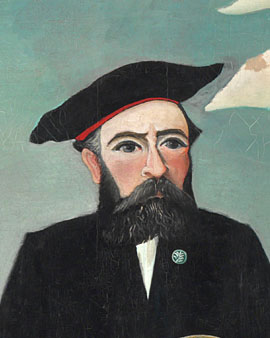The French painter Henri Rousseau (1844 to 1910) is one of the most important naive painters without academic training. One of his most famous works is entitled "The Sleeping Gypsy" (French: La Bohémienne endormie). Clear contours are as typical of Rousseau's painting as the strong colours. The lying figure is painted "wrong" in perspective, it should tip over at any moment.
But the viewer only casually takes note of these supposed errors. The impression of an unmistakable visual language beyond any correct depiction of reality prevails. A dreamlike mood emanates from this picture, because the viewer is aware of the absolutely unrealistic picture design and yet feels drawn into a completely independent pictorial world.
The poet and contemporary of Rousseau, Guillaume Apollinaire, described the painter as primitive and his painting as naive. Both qualities are repeatedly attributed to Rousseau; Kandinsky sees the autodidact on the way to great realism.
No matter how Rousseau's work is placed in the history of art, his very own, fascinating painting style remains undeniable. The viewer recognizes a Rousseau at first glance, without any surprises, as in the painting "The Railroad Track". The picture shows a city view in winter and is characterised by clear colours and lines. The coldness of the winter day can be felt, at the same time the arrangement seems to be able to tip over into an abstract pictoriality of pure forms and colours at any time.
×





.jpg)
.jpg)
.jpg)
.jpg)
.jpg)
.jpg)
.jpg)
.jpg)
.jpg)
.jpg)
.jpg)
.jpg)
.jpg)
.jpg)
.jpg)
.jpg)
.jpg)
.jpg)
.jpg)
.jpg)
.jpg)
.jpg)
 1891 - (MeisterDrucke-38691).jpg)
 1891 - (MeisterDrucke-38691).jpg)
.jpg)
.jpg)
.jpg)
.jpg)
.jpg)
.jpg)
.jpg)
.jpg)
.jpg)
.jpg)
.jpg)
.jpg)
.jpg)
.jpg)
.jpg)
.jpg)
.jpg)
.jpg)
.jpg)
.jpg)
.jpg)
.jpg)
.jpg)
.jpg)
.jpg)
.jpg)
.jpg)
.jpg)
.jpg)
.jpg)
.jpg)
.jpg)
.jpg)
.jpg)
.jpg)
.jpg)
.jpg)
.jpg)
.jpg)
.jpg)
.jpg)
.jpg)
.jpg)
.jpg)
.jpg)
.jpg)
.jpg)
.jpg)
.jpg)
.jpg)
.jpg)
.jpg)
.jpg)
.jpg)
.jpg)
.jpg)
.jpg)
.jpg)
.jpg)
.jpg)
.jpg)
.jpg)
.jpg)
.jpg)
.jpg)
.jpg)
.jpg)
.jpg)
.jpg)
.jpg)
.jpg)
.jpg)
.jpg)
.jpg)
.jpg)
.jpg)
.jpg)
.jpg)
.jpg)
.jpg)
.jpg)
.jpg)
.jpg)
.jpg)
.jpg)
.jpg)
.jpg)
.jpg)
.jpg)
.jpg)
.jpg)
.jpg)
 - (MeisterDrucke-136171).jpg)
 - (MeisterDrucke-136171).jpg)
.jpg)
.jpg)
.jpg)
.jpg)
.jpg)
.jpg)
.jpg)
.jpg)
.jpg)
.jpg)
.jpg)
.jpg)
.jpg)
.jpg)
.jpg)
.jpg)
.jpg)
.jpg)
.jpg)
.jpg)
.jpg)
.jpg)
 - (MeisterDrucke-58470).jpg)
 - (MeisterDrucke-58470).jpg)
.jpg)
.jpg)
.jpg)
.jpg)
.jpg)
.jpg)
.jpg)
.jpg)
.jpg)
.jpg)
.jpg)
.jpg)
.jpg)
.jpg)
.jpg)
.jpg)
.jpg)
.jpg)
.jpg)
.jpg)
_1894_-_(MeisterDrucke-802279).jpg)
_1894_-_(MeisterDrucke-802279).jpg)
.jpg)
.jpg)
.jpg)
.jpg)
.jpg)
.jpg)
.jpg)
.jpg)
.jpg)
.jpg)
 - (MeisterDrucke-121667).jpg)
 - (MeisterDrucke-121667).jpg)
.jpg)
.jpg)
.jpg)
.jpg)
.jpg)
.jpg)
 - (MeisterDrucke-680865).jpg)
 - (MeisterDrucke-680865).jpg)
 - (MeisterDrucke-114439).jpg)
 - (MeisterDrucke-114439).jpg)
.jpg)
.jpg)
.jpg)
.jpg)
 - (MeisterDrucke-134982).jpg)
 - (MeisterDrucke-134982).jpg)
 - (MeisterDrucke-141173).jpg)
 - (MeisterDrucke-141173).jpg)
.jpg)
.jpg)
.jpg)
.jpg)
.jpg)
.jpg)






